The Quest
On April 16, I was inspecting the bluebird nests here at the Museum. I was not working that day but happened to be in town and didn’t want to miss any exciting happenings inside the nest boxes, so I took a peek.
As I crossed the main parking lot I heard the unmistakable rattle of a kingfisher overhead. I looked up. There, streaking through the blue sky were three kingfishers. The birds seemed on a direct course for Ellerbe Creek and indeed, they all went down between the trees on the southwest side of the campus. Ellerbe Creek runs through the campus precisely where the birds ducked into the trees.
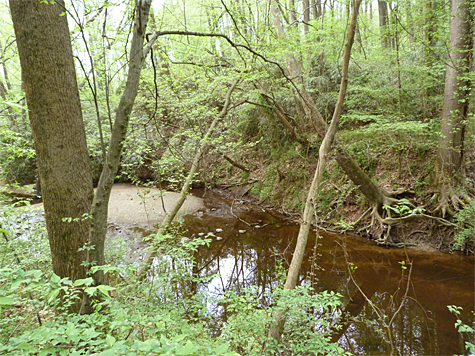
I remember years ago being told by Jim Keighton, former Museum employee, that kingfishers nest along Ellerbe Creek. At the time there was a well established Dinosaur Trail which ran through the woods along the creek. I naturally went to investigate. Sure enough, there it was, a kingfisher nest hole dug into the high bank of Ellerbe Creek.
I’d been thinking of searching for the nest of our current resident kingfisher along the creek for some time (for the last five years) but something else always seemed to get in the way. But now, I was here at the Museum, not working, it was time to investigate.
This has been a strange year for the kingfishers, there seems to be a new dynamic at work with the birds. A new female has shown up, the male seems to be hanging around more than usual, and there are three of them! This was all the excuse I needed, to see the three kingfishers flying overhead and ducking down into the trees, some free time on my hands (I was not working), and it was a nice warm day.
My quest didn’t take long. As I walked down to the creek, there it was, much as it was twenty years ago, on the far side of the creek about ten feet up on the bank, a hole about four or five inches high and just a bit less in width. It was a kingfisher nest and it was active, I could see a ridge running down the center of the walkway.
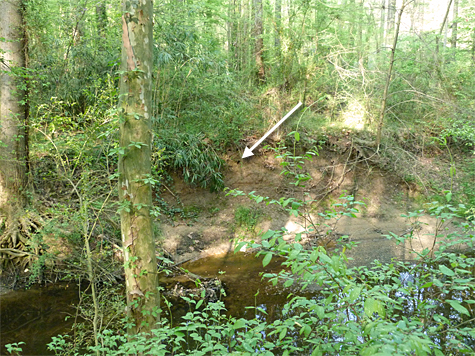
A kingfisher’s feet are wide-set and their legs are short. They don’t do much walking, mostly perching on a branch somewhere over water waiting for a fish to come by or flying wildly around a marsh or pond. The action of them walking in and out of the nest, with their wide-set and stumpy legs, leaves telltale ruts on either side of the entrance tunnel.
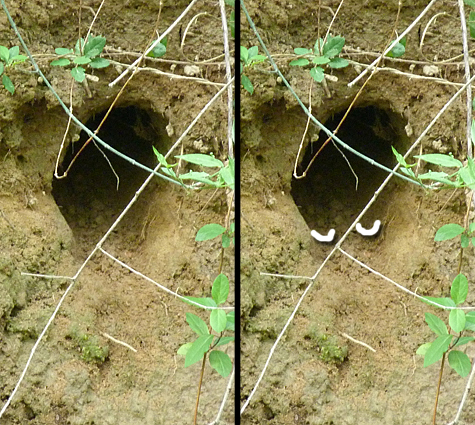
Before I could get out my camera, which should have been at the ready all along, a kingfisher wattled out of the hole and took off up the creek. The bird perched about 30 yards upstream rattling loudly, no doubt some kingfisher profanity directed at me for disturbing the peace.
I blew it. I wanted a picture of the bird either flying into or coming out of the nest hole. The bird probably would not fly back into the hole with me standing there. I retreated back up the slight slope away from the creek to give the birds some room. But it was too late, both a male and a female were there in the woods eyeballing my every move. They would not enter the nest again with me in the woods. I decided to leave and return the next day (another vacation day).
The next morning I arrived around 8 AM and slowly and quietly hiked into the woods. This time I wouldn’t approach the nest as closely as I had before and I would wait patiently for a bird to either exit or enter the hole while standing as still as I could.
My plan worked. About forty-five minutes after my arrival I heard a bird calling some 40 yards up stream. This was not the loud, raucous rattle typical of kingfishers but a quiet, gentle rattle. I don’t think the bird knew I was there. Apparently satisfied that there were no intruders in the area, the bird flew into the nest hole. I clicked off a shot, then another.
For some reason I waited with camera at the ready for a possible quick exit and it’s a good thing I did. The bird came back out of the hole no more than ten or fifteen seconds after entering and then poked back in again. The bird was apparently doing maintenance on the entrance tunnel, the third time it appeared at the entrance hole it was carrying what looked like a ball of mud and tossed it out of the hole.
My photos of the bird going into the nest hole are less than stellar, I refuse to publish one of them. I will, however show you several others.
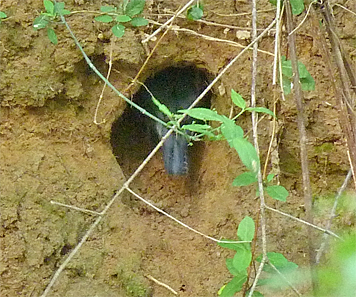
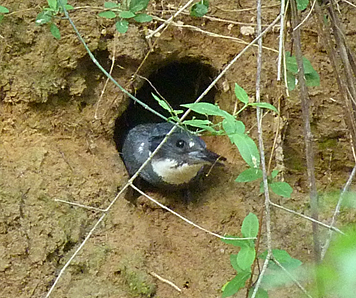
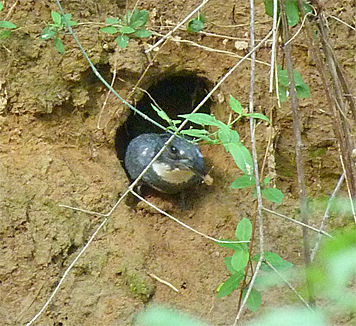
Some Kingfisher Natural History
Although kingfishers can and do sometimes nest in tree cavities I’ve never seen one do so. Their nests are almost always dug into the bank of a river, stream, or lake, but they’re sometimes far from their favorite fishing hole. Not every lake, pond of river has a sufficient bank in which to burrow.
I’ve seen one kingfisher nest dug into a mound of fill dirt at a construction site. There was a pond nearby but it lacked any sort of bank in which to burrow, the mound of dirt fit the bill. Fortunately, the fill dirt was not used by the construction workers during the period the birds were nesting, which would have destroyed the nest.
The nest is usually 2 or 3 feet down from the top of the bank. The entrance tunnel is typically 3 to 6 feet deep but has been recorded as much as 10 and 15 feet. The tunnel slants slightly upward towards the rear where it terminates in a relatively circular chamber about a foot in diameter and about half that in height.
The female usually lays 6 or 7 eggs but as many as 11 or 14 have been recorded, which is curious since I’ve never seen more than three young here at the Museum’s Wetlands when the parents finally bring them in for fishing lessons. Perhaps one parent takes half of the young to one fishing hole while the other parent escorts the others to another fishing hole for their first lessons. Or, maybe our female simply lays fewer eggs than the average.
The Conclusion
The kingfishers are most certainly nesting along Ellerbe Creek again this year. The nest site has probably been used for at least 20 years although I do not have data to substantiate that claim. It is, however, in the same bank and location as the nest I observed in the early 1990s which seems to indicate that it’s likely a traditional nest site for this species.
I can’t find any information on the longevity of Belted Kingfishers (how long they live) but the current occupants of the nest are probably not the original occupants. There is the possibility though, that one of them was hatched from this site. This is obviously a good site, and a good site is worth coming back to.
Love this post! Great work Greg. Kingfishers and Jumping Spiders get me every time.
Thanks, Kimberly!
What would we do without your eyes, Greg!